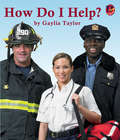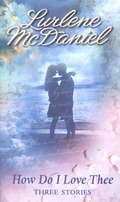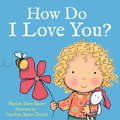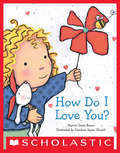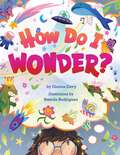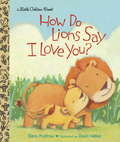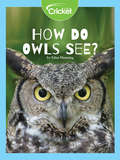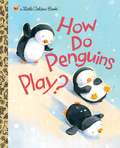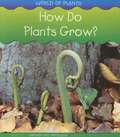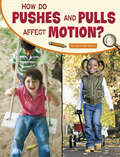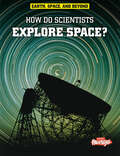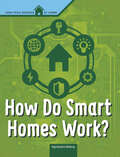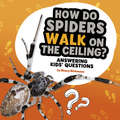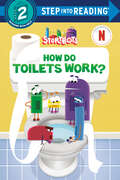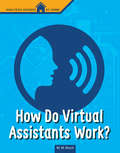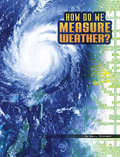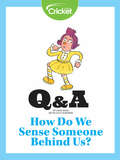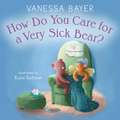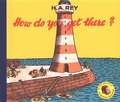- Table View
- List View
How Do I Grow?
by Robert CarolaAll children have curiosity about their bodies and how they work. Here are simple, straightforward answers to the how, what and why questions children ask.
How Do I Love Thee
by Lurlene McdanielThough written more than a century ago, Elizabeth Barrett Browning's beautiful sonnet rings true today for three young couples who believe in the power of love. <P> In "Night Vision," Brett finds a way to brighten a special girl's lonely existence.<P> "Bobby's Girl" features Dana, who must choose between two brothers, both of whom she loves.<P> "Laura's Heart," the third story, introduces 16-year-old Laura Carson, who is hospitalized on a regular basis because of her weak heart. But when tragedy strikes a loved one, she realizes her heart is stronger than she thought and that love lives on forever.
How Do I Love You?
by Caroline Jayne ChurchA heart-warming picture book about the power of unconditional love between a parent and a child, by bestselling artist Caroline Jayne Church.How do I love you? Let me count the ways.I love you as the sunloves the bright blue days.Through the seasons, and the ups and downs - love will shine through, whatever the weather. A charming exploration of love, using nature's many delights, to show just how much a child is loved.Caroline Jayne Church has won many awards and has sold over 6.5 million books worldwide.
How Do I Love You?
by Marion Dane BauerA rhyming story about a parent's unlimited love for a child -- in the same format as the bestselling book I Love You Through and Through, and with pictures by the same illustrator."How do I love you? Let me count the ways.I love you as the sun loves the bright blue days . . ."In this padded board book, a parent declares her love...as the bees love a flower, a duck loves a shower, a bird loves to sing, a bear loves the spring. Written by Newbery-award-winning author Marion Dane Bauer, inspired by the poem by Elizabeth Barrett Browning, and with pictures by Caroline Jayne Church, illustrator of the bestselling I Love You Through and Through.
How Do I Wonder?
by Gianna DavyThrough lyrical text and vivid images, How Do I Wonder? invites young readers to open the door to their miraculous minds, exploring the wacky and wonderful 'What-ifs' and 'Whys' of the world around—and within—them."A thought-provoking tale with a much-needed message: The mind is a place of limitless wonders."—Kirkus Reviews A book can be a powerful tool to spark creativity and imagination. Do snails view turtles as slow? Why is water wet? From the author of No One Owns the Colors comes an entertaining and beautifully illustrated picture book that shows children how to ask questions that help them see the world in a different way. Written and illustrated for all children, each page showcases a diverse and engaging world and helps kids ages 4-8 develop a growth mindset. Let the silly prompts show how the joy of a simple question can entertain the mind and spirit, no matter where you happen to be. • Curriculum Connection—Creative prompts help open up pathways to discovery and spark a catalyst to classroom engagement. • Infinite Curiosity—Teach the innate sense of wonder that demonstrates joy is everywhere, not just in a certain place. • Evocative Words—The lyrical text is entertaining to read and the vivid imagery helps keep the curiosity in children flowing. Start helping your little ones see the world in a new way with How Do I Wonder?
How Do Lions Say I Love You? (Little Golden Book)
by Diane MuldrowLions say "I love you" with a purr and a cuddle.Wolves say "I love you" with a howl and a huddle.Bears like to say it with a kiss on the muzzle.A mama cow says it with a lick and a nuzzle. . . .Sweet, simple rhymes and glowing illustrations in soft pastels show the touching ways that animals--from elephants to giraffes to chickens--bond with their families.
How Do Owls See?
by Edna ManningOwl eyes function much like human eyes but with some small differences.
How Do Penguins Play? (Little Golden Book)
by David Walker Elizabeth DombeyThis playful rhyming Little Golden Book asks, "How do penguins play?" Children will delight in watching bear cubs, seals, penguins, monkeys, and other animal friends frolicking joyfully with each other. Adorable pastel illustrations show these animals playing king-of-the-hill, keep away, and other fun and familiar games.
How Do Plants Grow? (World Of Plants Ser.)
by Louise Spilsbury Richard SpilsburyLooking inside a seed. We'll look at a cut-open bean seed and talk about the food store and the baby plant and the seed coat. The baby plant in a seed stays safe and warm inside the seed coat until it is ready to start growing, usually in spring when the weather is warm and wet.
How Do Pushes and Pulls Affect Motion? (Science Inquiry)
by Lisa M. SimonsYou push your friend while they swing. You pull open a door. What happens when you push or pull an object? Let’s investigate pushing and pulling forces!
How Do Smart Homes Work? (High Tech Science at Home)
by Agnieszka BiskupImagine you arrive at school and realize you forgot to feed the dog. No problem. Pull out your phone and command the dog dish to dispense a serving of food. That's all there is to it - if you live a smart home. What once sounded like science fiction is now a reality for some families. People use smart phones and other devices to lock doors, turn on lights, close window shades, and check to see how much milk they have in the fridge. Find out how this technology works and what the future holds for smart homes.
How Do Spiders Walk on the Ceiling?: Answering Kids' Questions (Questions and Answers About Animals)
by Nancy DickmannSpiders live everywhere! We even find them inside our homes. But how do they get way up on the ceiling? You have questions, and this book has the answers. Find out about spiders, including their body parts and behavior.
How Do Toilets Work? (Step into Reading)
by Random HouseThe robots from Netflix's Ask the StoryBots star in an all-new Step 2 Step into Reading leveled reader about how toilets work.We use the toilet every day, but how does it work—and where does our waste go? Join the StoryBots for an amazing adventure into the toilet, through the plumbing, and beyond. What they learn will fascinate children ages 4 to 6 who love Netflix's educational show.Step 2 Readers use basic vocabulary and short sentences to tell simple stories. For children who recognize familiar words and can sound out new words with help. Check out the other book in the series:Tyrannosaurus RexTriceratopsVelociraptorsThe Moon&’s Turn to ShineStop That Virus!
How Do Virtual Assistants Work? (High Tech Science at Home)
by M. M. EbochA virtual assistant by any name - Alexa, Siri, whoever - can be a sweet addition to your home. You might use one for simple jobs like playing music or streaming podcasts. And you might use one to communicate with friends and remind you about homework coming due while helping you make your breakfast. Find out how digital assistants work and what the future might hold for this part of a high-tech home.
How Do We Classify Materials? (Science Inquiry)
by Yvonne PearsonScientists put things into groups so they are easier to study. Materials have different properties. What are they, and how they are grouped? Let’s investigate materials!
How Do We Elect Our Leaders? (My American Government)
by William David ThomasIn what ways are the branches of government like a basketball game? How can a school yard game's rules liken themselves to a constitution? Through engaging analogies and introductions, our new government series gets students ready for election 2008. Correlated to the fourth and fifth grade social studies curriculum, My American Government introduces students to how our government works. Students learn about the U.S. Constitution, the branches of government, citizens' basic rights, and how we elect our leaders.
How Do We Measure Weather? (Discover Meteorology)
by Nancy DickmannHow fast is the wind blowing? How much moisture is in the air? Meteorologists measure weather conditions to help answer these and other questions. Learn about the tools and systems they use. Find out how these measurements help people plan their days and prepare for any weather.
How Do We Predict Weather? (Discover Meteorology)
by Nancy DickmannWill tomorrow be cold or warm? Cloudy or sunny? Wet or dry? Meteorologists make predictions about how weather conditions will change. Find out how they do it and what challenges they face in trying to help people prepare for coming weather conditions.
How Do We Prepare for Severe Weather? (Discover Meteorology)
by Nancy DickmannA storm is coming! How do people prepare? What supplies and tools do we need to survive? Find out how people prepare for all kinds of severe weather. From tornadoes to hurricanes and blizzards to floods, we can be ready for anything.
How Do We Sense Someone Behind Us?
by Lizzie WadeHow do humans sense when someone is behind them? This Q & A explains the science of peripheral vision.
How Do We Use Light? (Science Inquiry)
by Emily RaijLight is all around us. What is light? Where does it come from? How does it help us see? Readers investigate and read straightforward text accompanied by vibrant photos to learn all about light.
How Do You Care for a Very Sick Bear?
by Vanessa BayerFrom debut children's author Vanessa Bayer and illustrator Rosie Butcher, How Do You Care for a Very Sick Bear? is a sweet picture book with advice for children—and adults—for dealing with a sick friend.You and your friend Bearare an excellent pair.But if your friend gets sick, And can’t do all the things that you two love to do…You may wonder--how do you care for a very sick Bear?When someone dear is dealing with illness, it's difficult to know what to do or say. The actor Vanessa Bayer experienced this firsthand when she was treated for childhood leukemia. In her first children's book, she offers gentle, reassuring advice that people of all ages will appreciate.
How Do You Get There?
by H. A. ReyIn How Do You Get There? children guess the means of transportation to be used.

